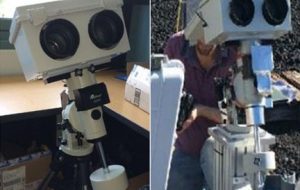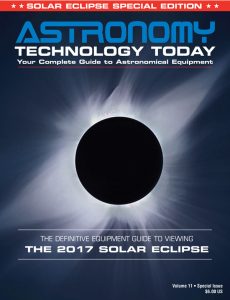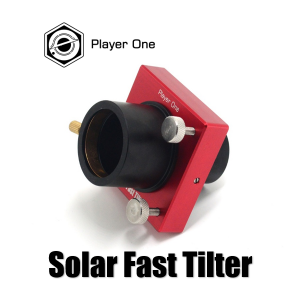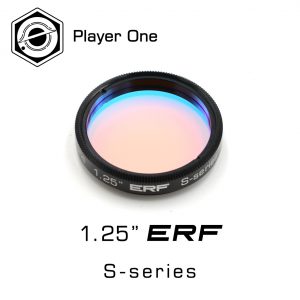Guest News Announcement from Roger Rivers with iOptron
As the nation’s premier astronomy exposition, the Northeast Astronomy Forum serves as an excellent venue to network with amateur and professional astronomers who utilize iOptron products. This past NEAF I had the pleasure to meet Dr. Josh Walawender, Support Astronomer at W. M. Keck Observatory.
Josh introduced us to the PANOPTES Project (Panoptic Astronomical Networked Observatories for a Public Transiting Exoplanets Survey) which searches for exoplanets with the help of schools and amateur astronomers. This is a citizen science project which aims to build low cost, robotic observing units which can be used to detect transiting exoplanets using the transit technique, the most accessible way to discover exoplanets. When the planet passes in front of its star, the star appears to dim, as some of its light is blocked by the planet (stars and exoplanets are too small to see image the transit, so only the total flux is measured). The dimming can be large (about one percent for a Jupiter-like planet), so it can be measured using relatively inexpensive equipment that amateur astronomers and schools can afford. By measuring how much and how often the star dims, the planet size and distance can be determined.

Discovering exoplanets by the transit method is challenging because the odds are small that you will observe such an event when looking at a single star. The planet orbit alignment has to be just right (for most planet/star systems, the planet never passes in front of the star, but goes “around” it), and the transit does not last very long and may not repeat very frequently.
The key to beat the small odds is to monitor, as continuously as possible, a very large number of stars. To achieve this, the project’s goal is to design and place economical observation units that are easy to assemble and operate, yet reliable and low-cost. The beta unit uses an iOptron iEQ30 mount carrying a camera box with two cameras and lenses. By placing many of these observational units at various locations the project aims to greatly increase the number of exoplanets discovered. For more information visit the projects website at: http://www.projectpanoptes.org
PANOPTES Observation Unit
The philosophy behind the PANOPTES hardware and software design is to use as many commercial off the shelf (COTS) parts as possible as these are generally inexpensive and easily acquired. In addition, the PANOPTES design is kept as simple as possible as this makes the build process easier and means that the final product is more reliable. The hardware for a PANOPTES baseline unit is divided in to three components:
Camera Box: The camera box encloses the two cameras and lenses along with an electronics (Arduino) board and a USB hub. One power and one signal (USB) cable come up through the mount to the camera box. The USB hub then splits the USB signal out to the Arduino and to both cameras. The power goes to the electronics board which regulates it down to the appropriate voltage for the cameras. The electronics board contains several sensors including the accelerometer to sense the orientation of the camera box.
The Mount and Tripod/Pier: The PANOPTES baseline uses an iOptron iEQ30 Pro mount to which is added weatherproofing. The mount can either sit on the standard tripod, or on an optional PANOPTES designed pier for more permanent installation. A PANOPTES unit does not require a traditional observatory enclosure (e.g. a dome or roll off roof). It is designed to withstand weather when it is in its park position. This greatly simplifies the build and the software for the system.
The Control Box: The control computer, power supplies, and supporting electronics all sit in a weatherproof enclosure next to the mount. A PANOPTES unit is designed to be self-contained, requiring only input external power and internet connectivity.
###
 The Astronomy Technology Today editorial staff would like to take this opportunity to remind you of the availability of our Solar eclipse equipment guide – The Definitive Equipment Guide to the 2017 Solar Eclipse. Our goal with the 40 page publication is to provide an easy-to-consume introduction to the technological options for viewing and imaging the Great Solar Eclipse. We cover the gamut of options available including building you own solar viewer, solar glasses, smart phones, DSLR cameras, using astronomy telescopes, solar telescopes, using binoculars, solar filters (including a DYI filter option), CCD astro cameras, astro video cameras, webcams and much more. You can view the guide on our website here – its free and there is no requirement to sign up to read the guide.
The Astronomy Technology Today editorial staff would like to take this opportunity to remind you of the availability of our Solar eclipse equipment guide – The Definitive Equipment Guide to the 2017 Solar Eclipse. Our goal with the 40 page publication is to provide an easy-to-consume introduction to the technological options for viewing and imaging the Great Solar Eclipse. We cover the gamut of options available including building you own solar viewer, solar glasses, smart phones, DSLR cameras, using astronomy telescopes, solar telescopes, using binoculars, solar filters (including a DYI filter option), CCD astro cameras, astro video cameras, webcams and much more. You can view the guide on our website here – its free and there is no requirement to sign up to read the guide.



